For additional information relating to this article, please contact:
July 15, 2021FAMILY INCOME AND INDIVIDUAL INCOME, T1 FAMILY FILE, 2019 Statistics Canada has released estimates of family and individual income generated from 2019 T1 personal income tax returns. This data shows how income is changing over time for particular types of families as well as how it compares by type of income and geography.
Within Statistics Canada’s estimates, there are income results for those who are in census families (couples and lone-parent families) as well as for those who are not in census families.
The data shows median incomes for families (which often include more than one earner) as well as for persons within families (which allows for comparison with those who are not in census families). There are data available for provinces, for Census Metropolitan Areas (CMA), smaller Census Agglomerations (CA) and areas outside CMA and CA communities.
For Nova Scotia, the T1 records indicate a total of 931,720 persons (totals will not align with official population estimates). Of these, 67.0% were in couple families – the lowest such proportion among the provinces while there were 13.0% in lone-parent families (second highest among provinces) and 20.0% not in any form of census family (second highest among provinces).
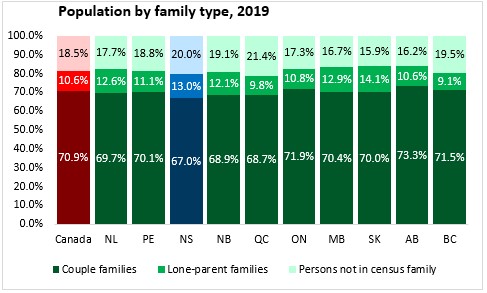
Within Nova Scotia, the portion of couple families is lower in New Glasgow and the Cape Breton Regional Municipality, where there are more lone-parent families as well as persons not in a census family.
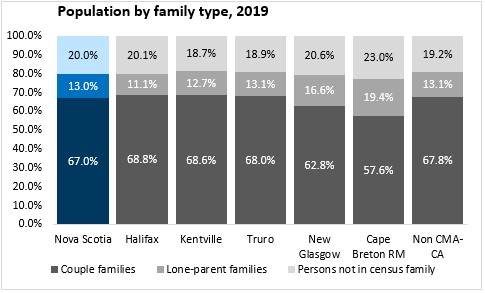
Over time, the share of Nova Scotia's population in census families has declined as has the share in lone-parent families. The population's share of persons not in a census family is rising (concentrated among older residents).
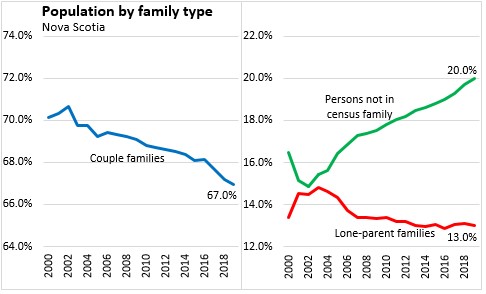
Median total income (among those who had income) for persons in couple families was $38,080 in Nova Scotia in 2019, which was 93.4% of the national average ($40,770). Median income from all sources among persons in lone-parent families who had income in Nova Scotia during 2019 was $30,780, 90.4% of the national median ($34,060). Median income from all sources among persons not in census families who had income was $28,400 or 91.1% of the national median ($31,190).
Note: median income of persons in couple families treats each person with income separately.

Within Nova Scotia, the Halifax CMA had higher median total income among couple families, lone-parent families, and persons not in families while areas outside of Halifax had lower median incomes across all family types.
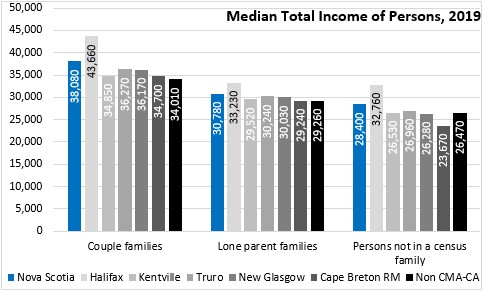
Nova Scotia's median income of persons in couple families grew by 2.5% from 2018 to 2019, slower than the national pace of 2.8%.
Income growth for Nova Scotia lone-parent families was 4.8% in 2019, faster than the national growth of 4.2%.
Among Nova Scotia's persons not in a census family, 2019 median income was 2.7% higher than in 2018, faster than the national median for this group (2.2%).
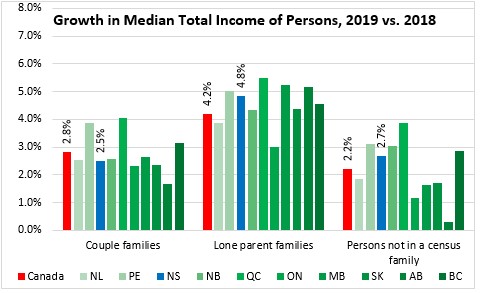
Median income growth was notably faster among lone parent families, particularly in Kentville, Truro and New Glasgow. Income growth was slower for persons not in a census family in the Cape Breton Regional Municipality.
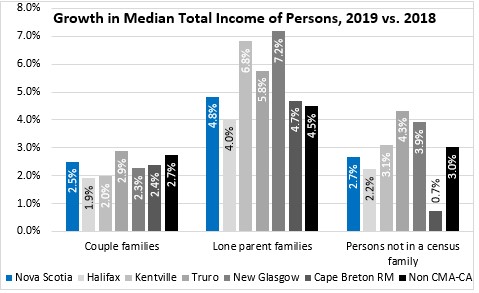
In recent years, income growth among lone parents has outpaced income growth for couples and persons not in a census family. This was observed at both the national and provincial level.

Couple families typically report higher incomes, particularly for those that have two persons earning employment income. Nova Scotia reports the lowest proportion of dual earners among couple families at 54.4%. The share of dual earners among couple families is notably lower in Kentville, New Glasgow, Cape Breton Regional Municipality and rural Nova Scotia (outside of Halifax and the Census Agglomeration areas).
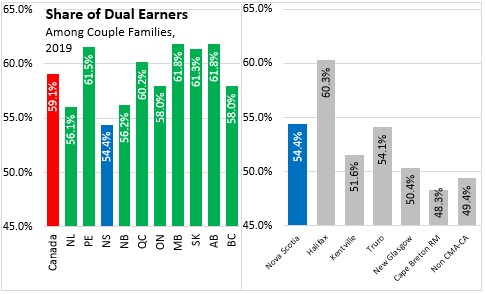
Among dual earner couples, Nova Scotia's median total earnings (combining the incomes of both earners) were $93,520 in 2019 (92.1% of the national median). Dual earner couples' income was notably higher in Halifax than across the rest of the province.
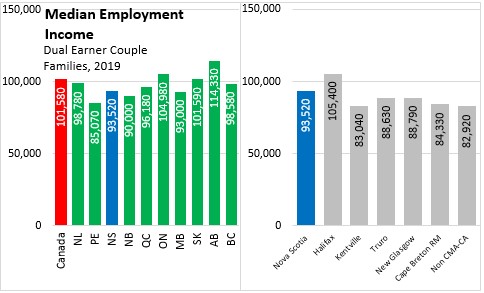
The Annual T1 Family File provides breakdowns of family income by income range.
Among couple families in 2019, there was a higher share of Nova Scotia families reporting less than $100,000 in income than the national average. The share of Nova Scotia couple families reporting incomes above $100,000 was below the national share in these income ranges.
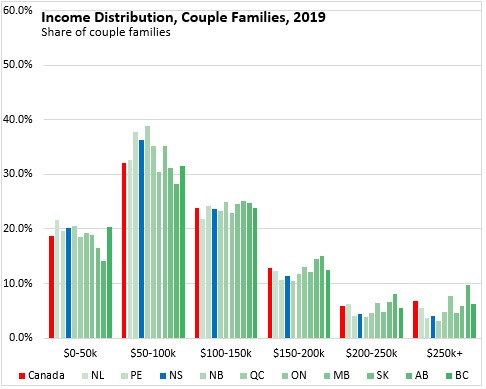
Across Nova Scotia, the share of couple families with total income over $100,000 was higher in Halifax than in the rest of the province.
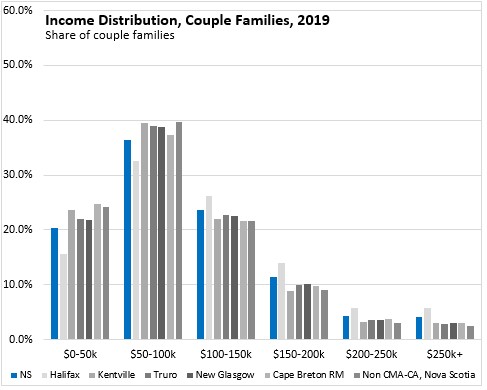
A larger portion of Nova Scotia lone parent families have total income under $50,000, compared with the national average. A smaller portion of Nova Scotia lone parent families report incomes in excess of $50,000.
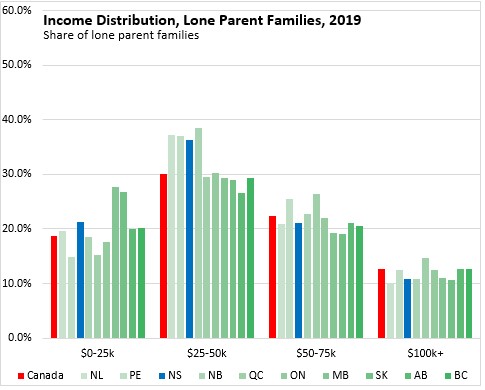
Across the province, a larger portion of lone parent families report income over $50,000 in Halifax (compared to the provincial average). Outside the city a larger portion of lone parent families report incomes under $50,000.
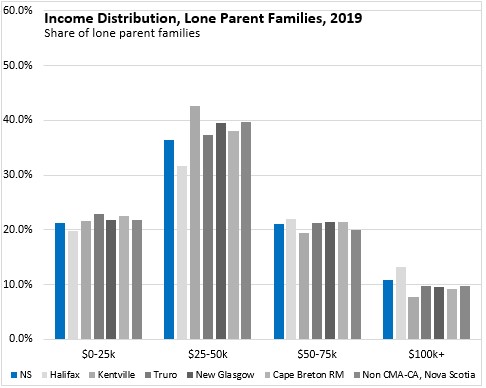
A higher portion of Nova Scotians not in a census family report incomes less than $50,000 (compared to the national average) while a lower portion report incomes in excess of $50,000.
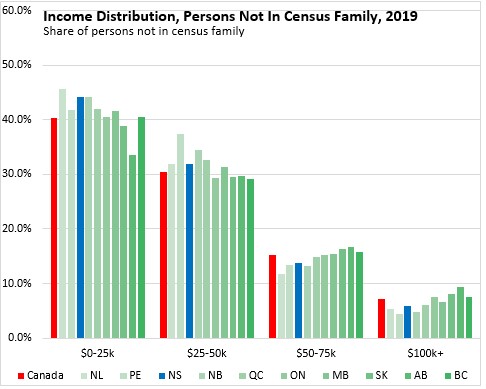
Across the province, a higher portion of Halifax's persons not in a census family report incomes in excess of $50,000 (compared to the provincial average) while a higher portion of persons not in a census family outside the city report incomes under $50,000.
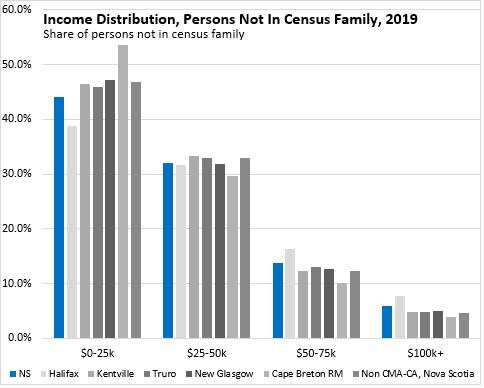
Nova Scotia couple families had the smallest share of total income from employment income in 2019 at 68.6%. Nationally, 73.2% of total income reported by couples was derived from employment income with the highest share in Alberta (76.4%). Nova Scotia couples report the highest share of income from pension sources (private pensions, RRSPs, CPP and OAS). Incomes from interest and dividends are higher in British Columbia, Alberta and Saskatchewan.

Across Nova Scotia, employment makes up a larger share of couple family income in Halifax. CPP/OAS/pensions make up a larger share of income in outside Halifax.

Child benefits accounted for 1.5% of total income of couples in Nova Scotia, but it was much higher at 9.7% of the income of lone-parent families in the province. Lone-parent families across Canada all report 65.7% of their income from employment earnings while employment earnings made up 63.9% of the income of lone parents in Nova Scotia.
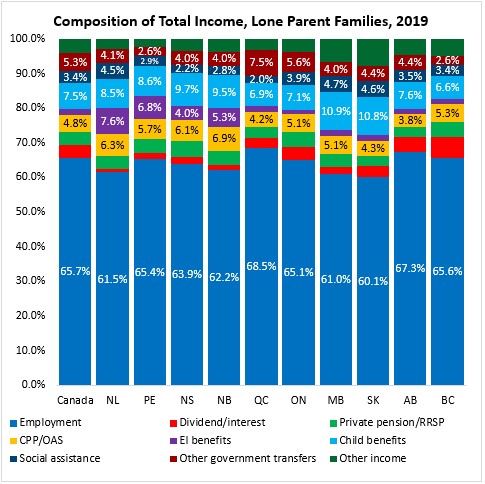
Within Nova Scotia, lone parents in Halifax reported a higher share of income from employment and a lower share from government transfers. Lone parents in the Cape Breton Regional Municipality reported a lower portion of income from employment and higher portions from child benefits and Employment Insurance.
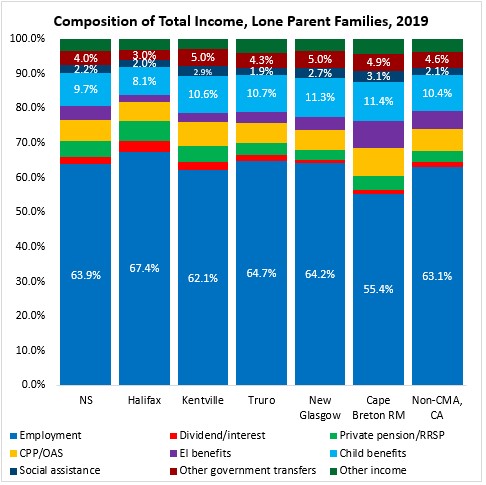
Persons not in a census family draw a much larger portion of their income from pension sources: private pensions, RRSPs, CPP and OAS. This is particularly the case in Atlantic Canada, where older populations reduce the share of the population in the labour force.

Pension income is particularly important as a source of income in communities outside of Halifax.
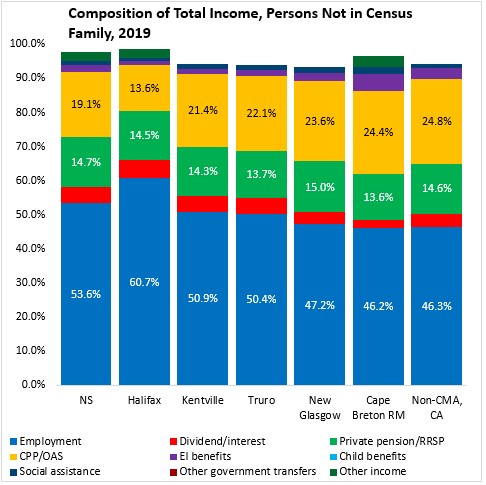
Measuring total income taxes paid to Provincial and Federal governments (and removing the Quebec abatement on Federal income taxes), the average national income tax rate was 16.9% of total national income in 2019. Nova Scotia's average income tax rate is 17.3% of total income. The highest average income tax rates were in Ontario, Alberta and Newfoundland and Labrador. The lowest average income tax rates were in Quebec and New Brunswick. Average income tax rates were higher in Halifax than across the rest of the province.
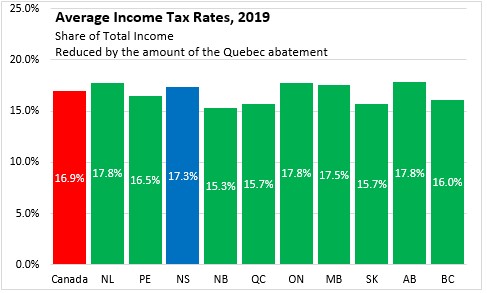
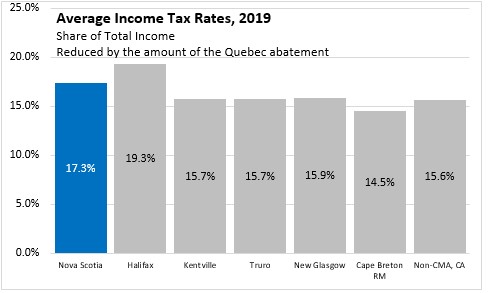
Statistics Canada Notes:
In this release, income levels have been adjusted for inflation as measured by the Consumer Price Index, and are expressed in 2019 constant dollars.
Total income includes employment income, dividend and interest income, government transfers, pension income and other income. In accordance with international standards, capital gains are excluded from total income.
This release uses the census family concept. A census family refers to a married or a common-law couple, with or without children at home, or a lone-parent family. Results also include persons not in a census family.
Statistics Canada. Table 11-10-0009-01 Selected income characteristics of census families by family type ; Table 11-10-0014-01 Sources of income by census family type ; Table 11-10-0034-01 Tax filers and dependants with income by sex, income taxes, selected deductions and benefits